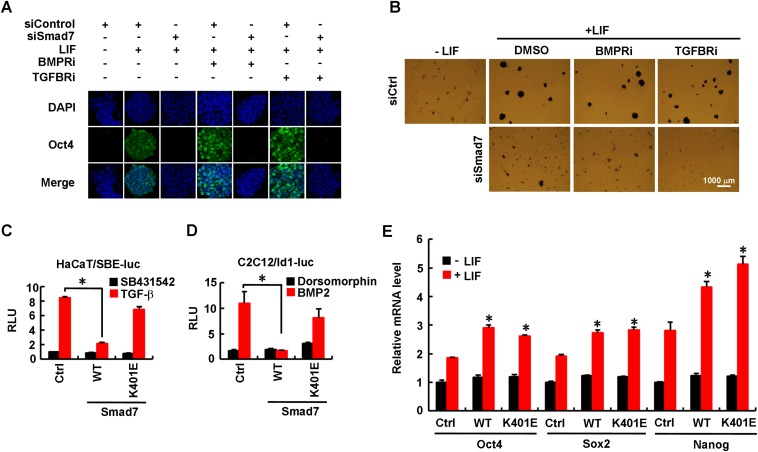Fig. S3.
Smad7 promotes pluripotency independent of canonical TGF-β/Smad signaling. (A) siSmad7 inhibits Oct4 expression independent of TGF-β/BMP signaling. CGR8 cells were transfected with 40 pM Smad7 siRNA or control siRNA and then split into six-well plates at a low density. Transfected cells were treated with TGFBRi or BMPRi for 3 d. Cells were fixed and immune stained with anti-Oct4 antibody. DNA was stained with DAPI. (B) siSmad7 inhibits ES cell colony formation independent of TGF-β/BMP signaling. CGR8 cells were transfected with siRNAs as described in Fig. S3A. Transfected cells were treated with TGFBRi or BMPRi for 5 d, and then fixed and subjected to AP staining. (C) Smad7 mutant K401E does not inhibit the TGF-β–induced SBE–luc reporter activity. HaCaT cells were cotransfected with wild-type Smad7 (WT) or Smad7–K401E together with the Smad-binding element (SBE)–luc reporter (a synthetic TGF-β–responsive reporter), followed by stimulation with 5 μM SB431542 (TGF-β type I receptor inhibitor) or 2 ng/mL TGF-β for 12 h. Cells were harvested for luciferase assay. Data are shown as mean ± SEM; n = 3. *P < 0.05. (D) Smad7 mutant K401E does not inhibit the BMP-induced Id–luc reporter activity. C2C12 cells were cotransfected with wild-type Smad7 (WT) or Smad7–K401E together with the expression plasmid for Id1–luc reporter (a luciferase reporter driven by the Id1 promoter containing the BMP-responsive element), followed by stimulation with 10 μM Dorsomorphin (BMP type I receptor inhibitor) or 50 ng/mL BMP2 for 12 h. Cells were harvested for luciferase assay. Data are shown as mean ± SEM; n = 3. *P < 0.05. (E) Smad7 promotes ESC stemness independent of its ability to bind to TβRI or BMPRI in ESCs. CGR8 cells were transfected with FLAG–Smad7 (WT), the K401E mutant or control plasmid and then treated with or without 0.1 ng/mL LIF for 48 h. Total RNAs were extracted from cells and subjected to qRT-PCR to examine expression level of indicated pluripotency markers. Data are shown as mean ± SEM; n = 3. *P < 0.05.

